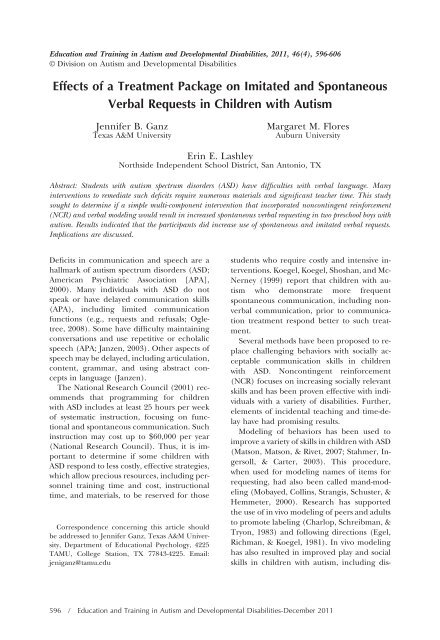etadd_46(4) - Division on Autism and Developmental Disabilities
etadd_46(4) - Division on Autism and Developmental Disabilities
etadd_46(4) - Division on Autism and Developmental Disabilities
You also want an ePaper? Increase the reach of your titles
YUMPU automatically turns print PDFs into web optimized ePapers that Google loves.
Educati<strong>on</strong> <strong>and</strong> Training in <strong>Autism</strong> <strong>and</strong> <strong>Developmental</strong> <strong>Disabilities</strong>, 2011, <str<strong>on</strong>g>46</str<strong>on</strong>g>(4), 596-606<br />
© <str<strong>on</strong>g>Divisi<strong>on</strong></str<strong>on</strong>g> <strong>on</strong> <strong>Autism</strong> <strong>and</strong> <strong>Developmental</strong> <strong>Disabilities</strong><br />
Effects of a Treatment Package <strong>on</strong> Imitated <strong>and</strong> Sp<strong>on</strong>taneous<br />
Verbal Requests in Children with <strong>Autism</strong><br />
Jennifer B. Ganz<br />
Texas A&M University<br />
Margaret M. Flores<br />
Auburn University<br />
Erin E. Lashley<br />
Northside Independent School District, San Ant<strong>on</strong>io, TX<br />
Abstract: Students with autism spectrum disorders (ASD) have difficulties with verbal language. Many<br />
interventi<strong>on</strong>s to remediate such deficits require numerous materials <strong>and</strong> significant teacher time. This study<br />
sought to determine if a simple multi-comp<strong>on</strong>ent interventi<strong>on</strong> that incorporated n<strong>on</strong>c<strong>on</strong>tingent reinforcement<br />
(NCR) <strong>and</strong> verbal modeling would result in increased sp<strong>on</strong>taneous verbal requesting in two preschool boys with<br />
autism. Results indicated that the participants did increase use of sp<strong>on</strong>taneous <strong>and</strong> imitated verbal requests.<br />
Implicati<strong>on</strong>s are discussed.<br />
Deficits in communicati<strong>on</strong> <strong>and</strong> speech are a<br />
hallmark of autism spectrum disorders (ASD;<br />
American Psychiatric Associati<strong>on</strong> [APA],<br />
2000). Many individuals with ASD do not<br />
speak or have delayed communicati<strong>on</strong> skills<br />
(APA), including limited communicati<strong>on</strong><br />
functi<strong>on</strong>s (e.g., requests <strong>and</strong> refusals; Ogletree,<br />
2008). Some have difficulty maintaining<br />
c<strong>on</strong>versati<strong>on</strong>s <strong>and</strong> use repetitive or echolalic<br />
speech (APA; Janzen, 2003). Other aspects of<br />
speech may be delayed, including articulati<strong>on</strong>,<br />
c<strong>on</strong>tent, grammar, <strong>and</strong> using abstract c<strong>on</strong>cepts<br />
in language (Janzen).<br />
The Nati<strong>on</strong>al Research Council (2001) recommends<br />
that programming for children<br />
with ASD includes at least 25 hours per week<br />
of systematic instructi<strong>on</strong>, focusing <strong>on</strong> functi<strong>on</strong>al<br />
<strong>and</strong> sp<strong>on</strong>taneous communicati<strong>on</strong>. Such<br />
instructi<strong>on</strong> may cost up to $60,000 per year<br />
(Nati<strong>on</strong>al Research Council). Thus, it is important<br />
to determine if some children with<br />
ASD resp<strong>on</strong>d to less costly, effective strategies,<br />
which allow precious resources, including pers<strong>on</strong>nel<br />
training time <strong>and</strong> cost, instructi<strong>on</strong>al<br />
time, <strong>and</strong> materials, to be reserved for those<br />
Corresp<strong>on</strong>dence c<strong>on</strong>cerning this article should<br />
be addressed to Jennifer Ganz, Texas A&M University,<br />
Department of Educati<strong>on</strong>al Psychology, 4225<br />
TAMU, College Stati<strong>on</strong>, TX 77843-4225. Email:<br />
jeniganz@tamu.edu<br />
students who require costly <strong>and</strong> intensive interventi<strong>on</strong>s.<br />
Koegel, Koegel, Shoshan, <strong>and</strong> Mc-<br />
Nerney (1999) report that children with autism<br />
who dem<strong>on</strong>strate more frequent<br />
sp<strong>on</strong>taneous communicati<strong>on</strong>, including n<strong>on</strong>verbal<br />
communicati<strong>on</strong>, prior to communicati<strong>on</strong><br />
treatment resp<strong>on</strong>d better to such treatment.<br />
Several methods have been proposed to replace<br />
challenging behaviors with socially acceptable<br />
communicati<strong>on</strong> skills in children<br />
with ASD. N<strong>on</strong>c<strong>on</strong>tingent reinforcement<br />
(NCR) focuses <strong>on</strong> increasing socially relevant<br />
skills <strong>and</strong> has been proven effective with individuals<br />
with a variety of disabilities. Further,<br />
elements of incidental teaching <strong>and</strong> time-delay<br />
have had promising results.<br />
Modeling of behaviors has been used to<br />
improve a variety of skills in children with ASD<br />
(Mats<strong>on</strong>, Mats<strong>on</strong>, & Rivet, 2007; Stahmer, Ingersoll,<br />
& Carter, 2003). This procedure,<br />
when used for modeling names of items for<br />
requesting, had also been called m<strong>and</strong>-modeling<br />
(Mobayed, Collins, Strangis, Schuster, &<br />
Hemmeter, 2000). Research has supported<br />
the use of in vivo modeling of peers <strong>and</strong> adults<br />
to promote labeling (Charlop, Schreibman, &<br />
Try<strong>on</strong>, 1983) <strong>and</strong> following directi<strong>on</strong>s (Egel,<br />
Richman, & Koegel, 1981). In vivo modeling<br />
has also resulted in improved play <strong>and</strong> social<br />
skills in children with autism, including dis-<br />
596 / Educati<strong>on</strong> <strong>and</strong> Training in <strong>Autism</strong> <strong>and</strong> <strong>Developmental</strong> <strong>Disabilities</strong>-December 2011
















